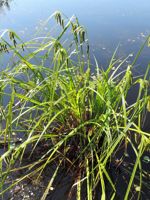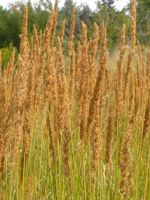Mon-Fri 9am - 5pm Mountain time
Cyperus-like Sedge vs Slimstem Reedgrass
Carex pseudocyperus
Calamagrostis stricta
CUSTOM GROW
CUSTOM GROW
Cyperus-like Sedge is a native perennial sedge found in wetlands, marshes, swamps, and along shorelines. Classified as an obligate wetland species, it grows in dense clumps that thrive in saturated soils, helping stabilize wet ground and protect shorelines. These colonies also provide cover for wildlife, while the seeds may be eaten by waterfowl and other birds. It is well-suited to wetland restoration, waterside and riparian zone plantings, and naturalization projects.
Its ornamental appeal comes from the contrast between the upright male floral spikes at the top of the stems and the long, drooping female floral spikes that hang below. These seed spikes resemble those of Cyperus species, giving the plant its common name and making it an attractive addition to naturalized plantings.
Slimstem Reedgrass is a native perennial bunchgrass commonly found in damp meadows, wetlands, and along streams and lakeshores. It thrives in wet, nutrient-poor soils and shows some tolerance to saline conditions. Typically a bunchgrass, it can also spread by rhizomes to form colonies, making it well-suited for soil stabilization, riparian zone planting, and wetland restoration projects.
Slimstem Reedgrass provides valuable cover for small animals and birds, and its dense growth can even serve as nesting habitat for waterfowl in wetland areas. Its seeds offer forage for wildlife, while the tall stems and floral spikes add texture and visual interest to the landscape.

